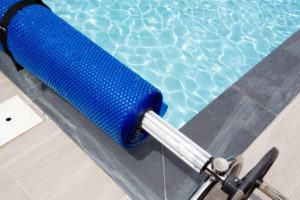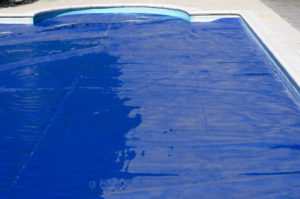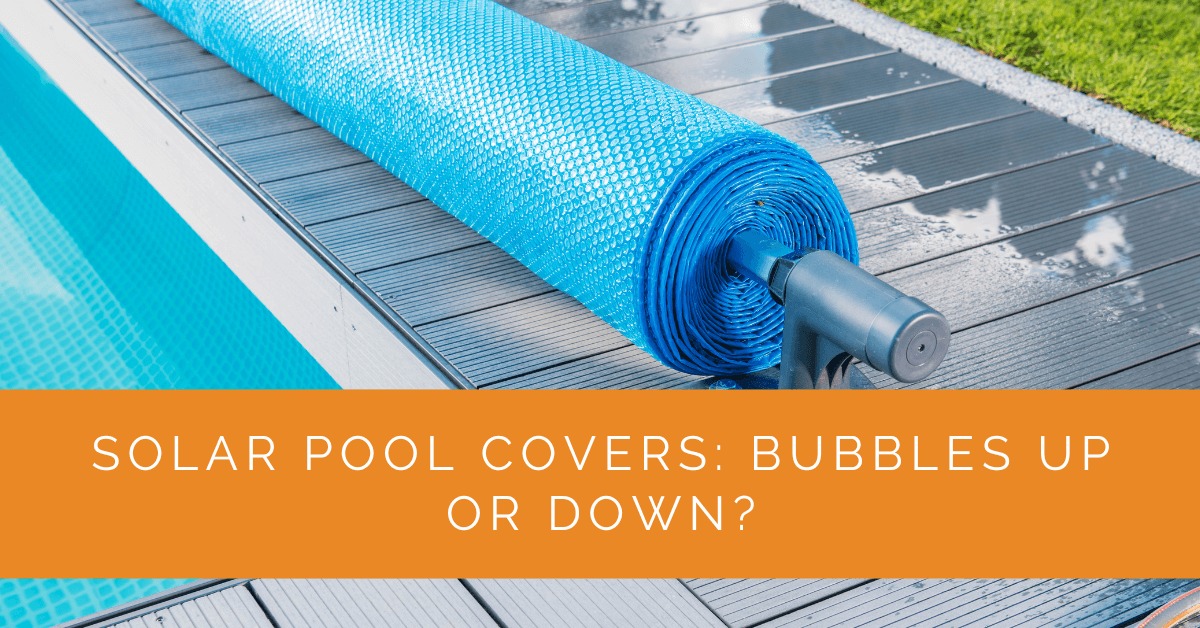As a pool owner, you strive to keep your pool water warm and inviting while minimizing energy consumption. One effective solution is using a solar pool cover, a solar cover, or a pool blanket. These covers harness the sun’s power to heat pool water and prevent evaporation. But the question arises: should you place the cover with the bubbles facing up or down? In this article, we will explore the debate surrounding the orientation of pool cover bubbles and provide insights on maximizing efficiency and heat retention.
Contents
Key Takeaways
- Placing the solar pool cover with the bubbles facing up is recommended, as it creates an insulating air gap that maximizes heat retention and reduces heat loss.
- While some argue that bubbles facing down enhance heat absorption, this configuration may increase debris accumulation and expose the cover to pool chemicals and UV radiation.
- Factors such as bubble size, thickness, sun exposure, and climate should be considered to optimize the efficiency and heat retention of the solar pool cover.
How Solar Pool Covers Work
The Science Behind Solar Pool Covers
Solar pool covers are made of a durable material that captures and retains the sun’s heat to warm your swimming pool. The secret lies in the cover’s design, which incorporates small bubbles. These bubbles act as a greenhouse, creating an insulating layer that traps heat and prevents it from escaping into the atmosphere.
When sunlight passes through the cover, it penetrates the bubbles and gets absorbed by the pool water. The absorbed heat warms the water, raising its temperature. At the same time, the cover acts as a barrier, reducing evaporation and heat loss from the pool’s surface.
Preventing Evaporation and Heat Loss
One of the primary benefits of using a solar pool cover is its ability to prevent evaporation. When pool water is exposed to the air, it evaporates, leading to water loss and energy inefficiency. A solar cover minimizes evaporation by creating a physical barrier that reduces the contact between the pool water and the atmosphere. By preserving water, you save on refilling costs and reduce chemical usage.
Furthermore, solar covers are designed to minimize heat loss. The bubbles in the cover create an insulating layer that prevents the warm pool water from losing heat to the cooler surroundings. This helps to retain the heat gained from the sun, extending your swimming season and reducing the need for additional heating methods.

Solar Pool Cover Orientation: Bubbles Up or Down?
The pool cover bubbles’ orientation has been a debate among pool owners. Some argue that the bubbles should face up, while others advocate for bubbles facing down. Let’s explore both perspectives and their implications for efficiency and heat retention.
Bubbles Up: The Recommended Method
The prevalent recommendation is to place the pool cover with the bubbles facing up. Here’s why:
Optimizing Heat Retention and Efficiency
When the bubbles face up, they create an air gap between the cover and the pool water’s surface. This air layer acts as additional insulation, further reducing heat loss. The trapped air creates a thermal barrier preventing the warm pool water from transferring heat to the cover directly. This configuration maximizes heat retention and enhances the overall efficiency of the solar pool cover.
Bubbles Down: Exploring the Alternative Approach
Some pool owners prefer placing the pool cover with the bubbles facing down. Here’s their argument:
Considerations and Trade-Offs
The rationale behind this approach is that having the bubbles in direct contact with the pool water enhances heat transfer. The bubbles facilitate better heat absorption by increasing the surface area in contact with the water. This configuration may lead to faster heat transfer from the cover to the pool water.
However, it’s essential to consider potential trade-offs. Placing the bubbles down can increase the risk of debris accumulation in the indentations of the cover, making it harder to clean. Additionally, direct contact between the bubbles and the pool water may reduce the cover’s lifespan due to increased exposure to pool chemicals and UV radiation.

Factors Affecting Solar Pool Cover Performance
Several factors influence the performance of solar pool covers. By understanding these factors, you can optimize your cover’s efficiency and heat retention.
Pool Cover Bubbles: Size and Thickness
The size and thickness of the bubbles play a role in how effectively the cover traps heat. Larger bubbles provide more insulation, while thicker bubbles offer enhanced resistance to heat loss. When selecting a solar pool cover, consider the size and thickness of the bubbles to ensure optimal performance.
Sun Exposure and Climate Considerations
The amount of sun exposure and the climate conditions in your region also impact the effectiveness of your solar pool cover. Regions with abundant sunshine and warmer climates generally benefit from solar covers. However, even in areas with less sun, a solar cover can still provide benefits by reducing evaporation and minimizing heat loss during cooler periods.
It’s crucial to adapt to regional variances and adjust your expectations accordingly. Monitoring the water temperature and evaluating the cover’s performance in your specific climate will help you make informed decisions to maximize efficiency.
Best Practices for Solar Pool Cover Usage
To make the most of your solar pool cover, consider the following best practices:
- Keep your pool covered with the bubbles facing up when the pool is not in use. This configuration optimizes heat retention and minimizes evaporation.
- Regularly clean the cover to remove debris and maintain its efficiency.
- Properly store the cover when not used to protect it from damage and prolong its lifespan.
- Monitor and adjust the cover position to ensure maximum sun exposure and coverage.
Pool Cover Bubbles Should Always…
For optimal efficiency and heat retention, pool cover bubbles should always face up when the cover is in use. This configuration creates an insulating air gap that prevents direct heat transfer from the pool water to the cover, maximizing the benefits of the solar pool cover.
Expert Insights About Solar Pool Covers: Bubbles Up or Down?
Positioning the bubbles up creates an insulating air layer, which significantly improves heat retention and reduces evaporation. This method optimizes energy efficiency for pool owners.
Senior Solar Pool Cover Specialist
Having the bubbles face down might seem beneficial for heat transfer, but it increases wear and tear on the cover and can lead to more debris accumulation, impacting the cover’s lifespan.
Pool Maintenance and Service Engineer
Maximizing sun exposure and regularly maintaining your solar pool cover can enhance its performance, whether the bubbles face up or down, but we recommend bubbles up for the best overall results.
Solar Energy Consultant
Our Expertise in Solar Products
At Solar Panels Network USA, we are dedicated to offering you valuable insights and assistance regarding solar products. With our deep-rooted knowledge and expertise in the solar product sector, our specialists are ready to guide you in discovering the ideal solar product for your requirements. Whether you aim to enhance your outdoor areas, save energy, or embrace a greener lifestyle, we are well-prepared to provide support. Don’t hesitate to contact us with any questions or inquiries.
Conclusion
When it comes to solar pool covers, the orientation of the bubbles plays a significant role in maximizing efficiency and heat retention. Placing the cover with the bubbles facing up provides superior insulation and reduces heat loss, ensuring your pool remains warm and inviting. By following best practices and understanding the factors that affect solar pool cover performance, you can harness the sun’s power and enjoy an energy-efficient swimming experience while minimizing water evaporation and heat loss.
About the Author
Solar Panels Network USA stands at the forefront of solar energy solutions, driven by a team of seasoned solar engineers and energy consultants. With over decades of experience in delivering high-quality solar installations and maintenance, we are committed to promoting sustainable energy through customer-centric, tailored solutions. Our articles reflect this commitment, crafted collaboratively by experts to provide accurate, up-to-date insights into solar technology, ensuring our readers are well-informed and empowered in their solar energy decisions.

